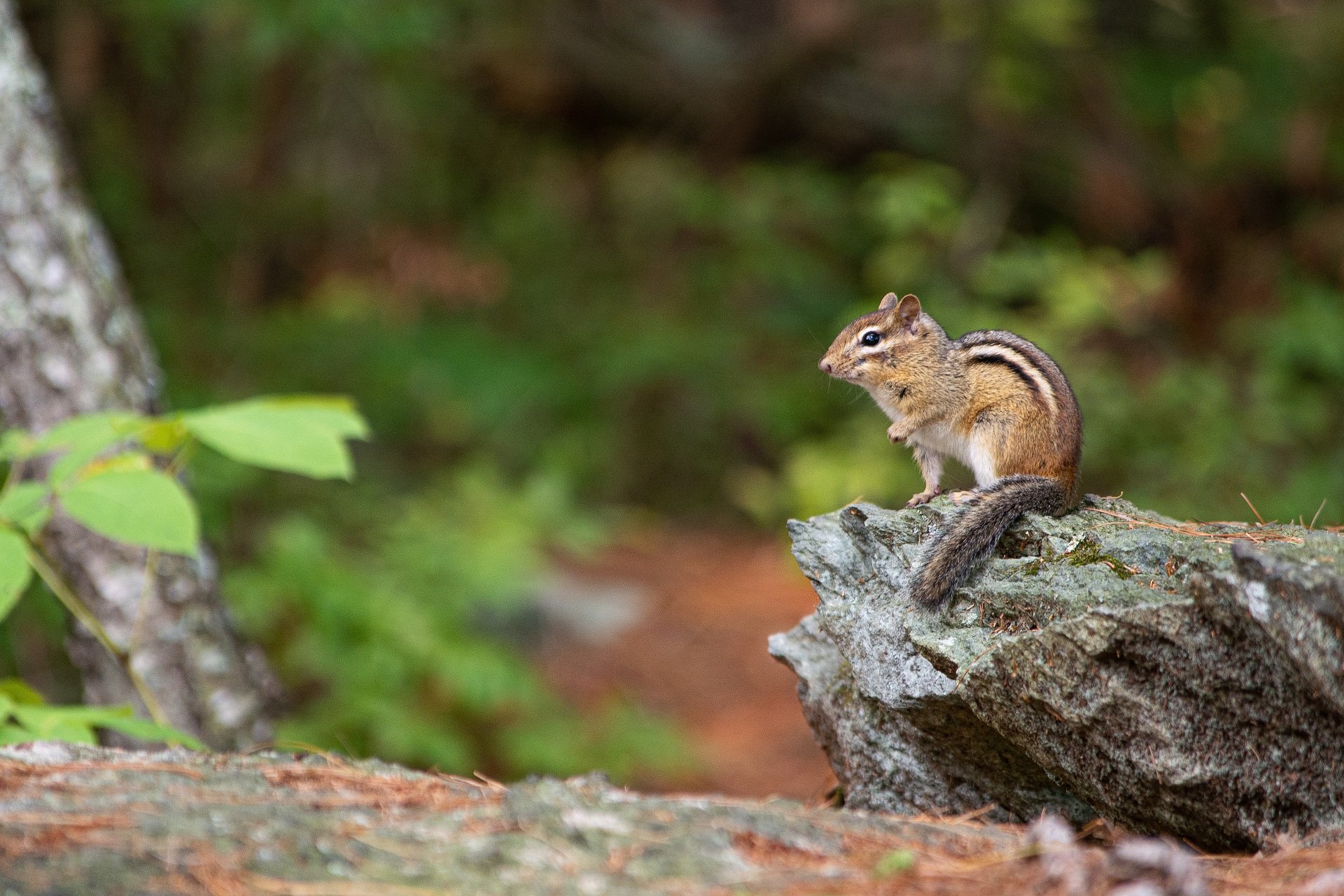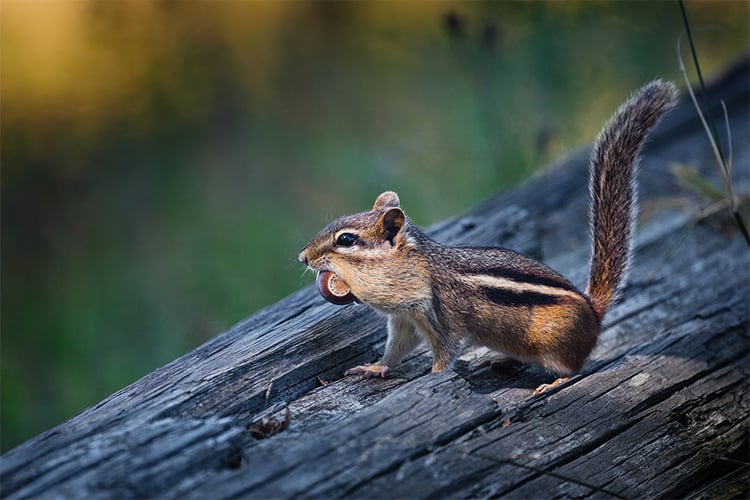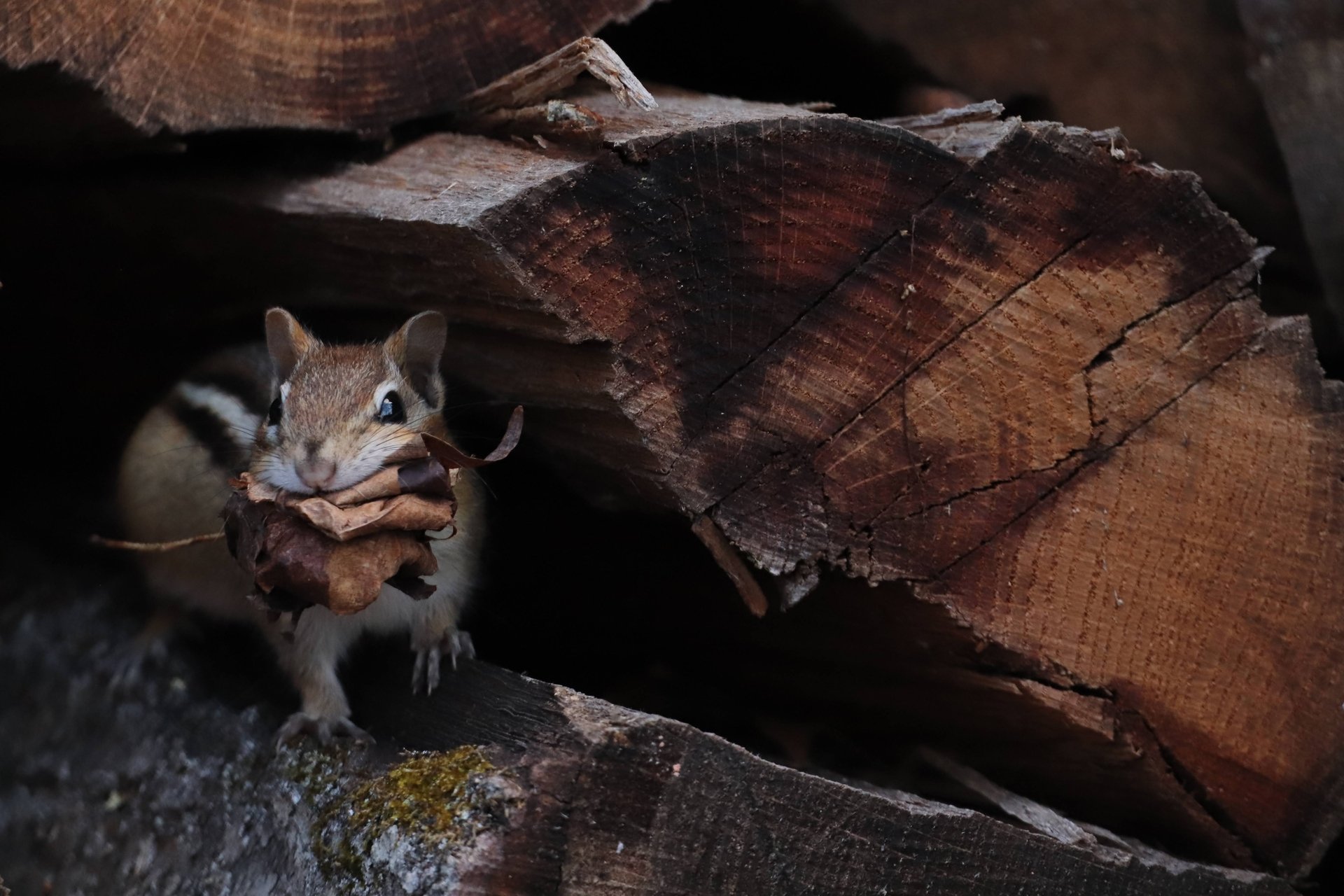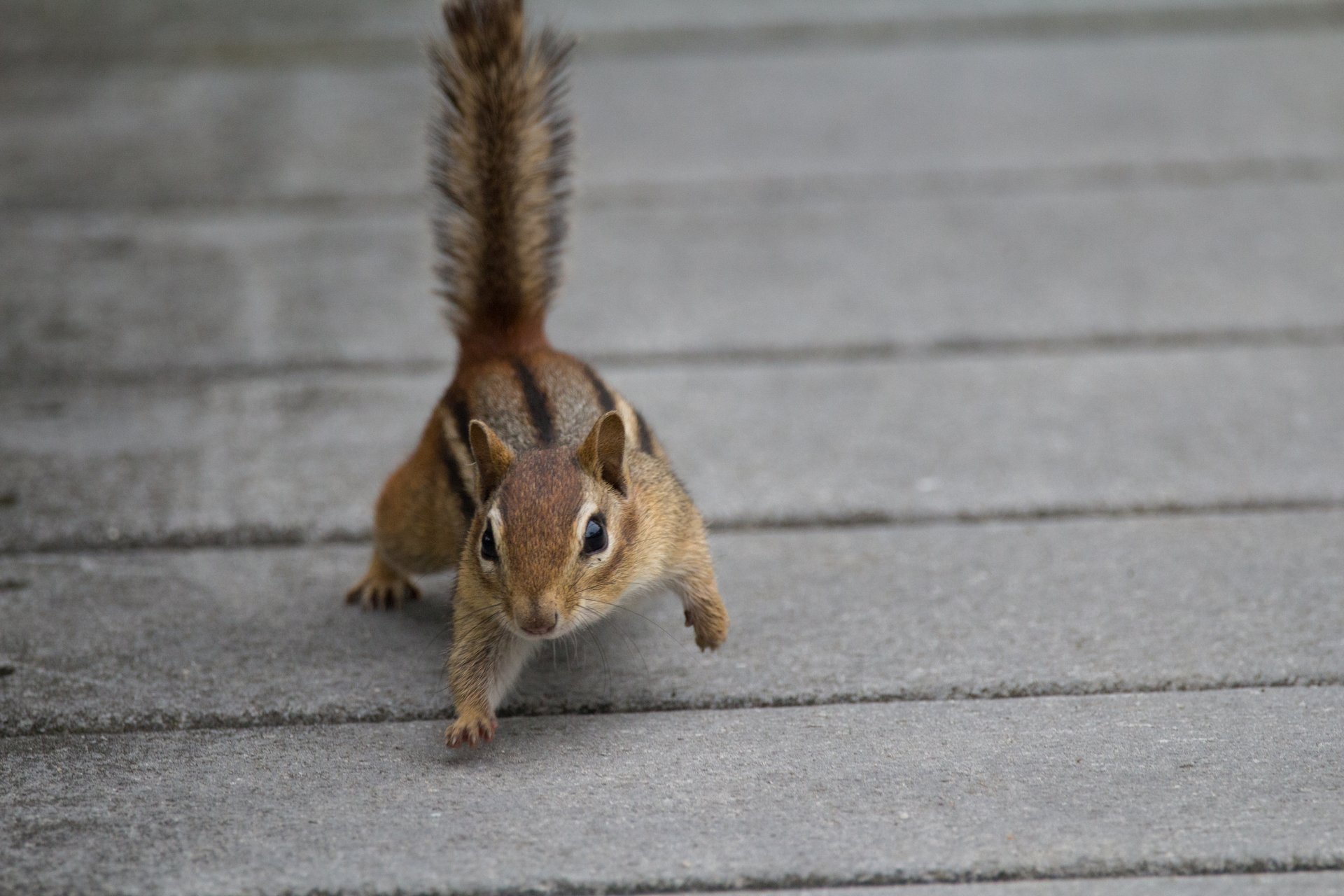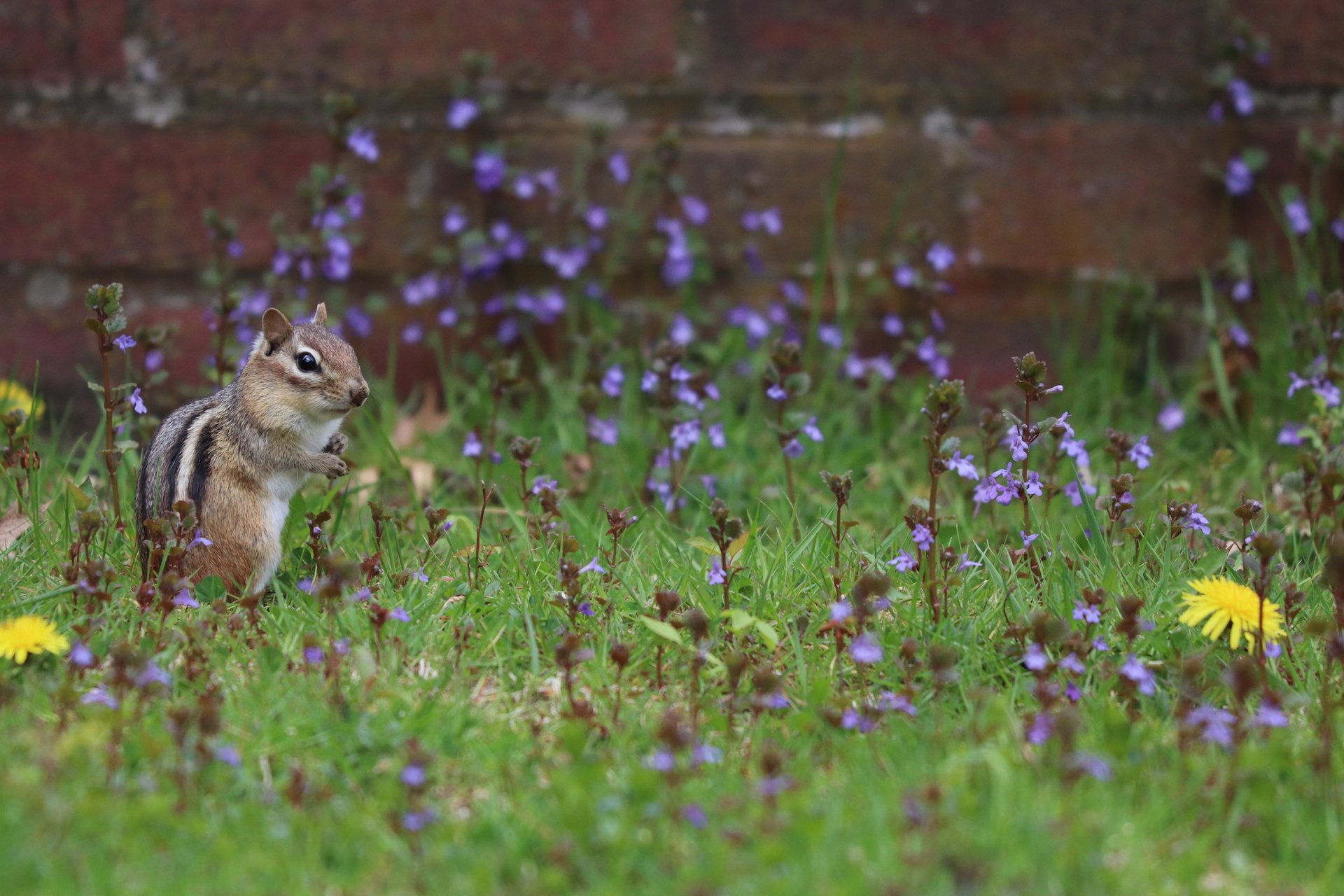Chipmunks
The Eastern Chipmunk is a member of the squirrel family. It's believed that the English word "chipmunk" was derived from "chetamnon," the name given to the animal by peoples of the Chippewa nation. Chipmunks are found throughout the United States, mainly in areas east of the Great Plains.
How to Identify Chipmunks
Chipmunks have short, dense fur that is a reddish rust color on top. There are five black stripes on the back—one down the center and two on each side that outline a white stripe. A white eye line stretches above and below each eye, separated by a band of black. With a body 5-6 inches long and a tail 3-4 inches long, chipmunks are about 1/3 the size of an Eastern Gray Squirrel. As chipmunks scamper along the ground, they hold their flat, hairy tail in the air.
Chipmunks are commonly seen in forests and woodlots, where they forage for food in leaf litter, as well as in suburban yards and city parks.
Chipmunk Behavior
What do Chipmunks Eat?
Seeds, berries, nuts, and fruit are the mainstays of a chipmunk's diet, but they also eat insects, insect larvae, slugs, snails, and earthworms. Occasionally they will even eat eggs, small birds, frogs, and small snakes.
Chipmunks store food in their cheek pouches before depositing it in their burrow. Researchers have reported seeing chipmunk' stuff nearly 72 black-oil sunflower seeds in their pouch. They are very territorial and will compete with other chipmunks for food patches.
Chipmunk Breeding
Eastern Chipmunks in Massachusetts usually mate twice a year, once in the early spring from March to early April and again from early June to mid-July. The female rebuffs the male after mating, and he does not share in the rearing of the young.
A litter of 2–5 tiny, hairless, and blind young—each no more than 2.5 inches long—are born after a 31-day gestation period. The first litter is generally born in April or May, and the second in July or August.
After six weeks, and under their mother's watchful eye, they begin taking short trips out of the burrow. At week 7 or 8, the mother becomes more aggressive toward her offspring to prepare them for independence. Two weeks later, the mother denies them access to the burrow, and the young are forced to disperse and find or dig their own shelter.
When the young disperse in the spring and fall, adults occupying nearby burrows give loud "chip-chip-chip" calls outside the burrow entrance—presumably to notify the newly-independent youngsters of occupied territory.
Do Chipmunks Hibernate?
Chipmunks are not true hibernators. Instead, they enter a torpid state during which their body temperature and heartbeat decrease. But they wake every few days to feed on stockpiled food and to defecate.
In Massachusetts, they enter their burrows in late October and, except briefly during warm spells, they do not emerge again until March or April. From spring to fall, chipmunks are diurnal (active during the day). Most of their waking hours are spent gathering and storing food in their burrows. Trees whose seeds ripen in the spring, such as red maple, are important food sources for chipmunks because there are few other seeds available in the spring and winter stores may be running low.
Chipmunk Burrows
Unlike squirrels, chipmunks live in borrows in the ground and rarely climb into trees. A chipmunk's burrow system is quite amazing. They dig an entrance hole 2 inches in diameter down to about 2 feet, then continue digging parallel to the surface for up to 10 feet before terminating the tunnel in a sleeping chamber. They'll then excavate chambers off the tunnel for storing food, defecating, and giving birth.
Once the chambers are complete, the chipmunk uses dirt to plug up the working tunnel and makes a new entrance hole without a mound of dirt. As a result, the new entrance—usually located under stone walls, fallen trees, or rocks—goes unseen by predators.
How to Deter Chipmunks
Chipmunks rarely enter homes intentionally—they prefer to set up their home underground. But, if there is an opening that provides easy access, the chipmunk may enter a home in search of food. Check for openings around foundations and bulkheads and seal with wood, metal, or caulking.
If a chipmunk is in the house or basement, try to confine it to one location and open windows and doors with direct access to the outdoors. The chipmunk will be attracted to the light and exit the building.
Sometimes, chipmunks will dig tunnels under patios and walkways. Chipmunks' burrows rarely cause structural damage and, in most cases, can be tolerated and should be left alone.
To keep chipmunks from gardens, place chicken wire or a hardware cloth flat on the ground over the freshly planted bulbs. The plants will grow up through the mesh, but the chipmunks cannot penetrate it.
Sick or Injured Chipmunks
As with most other rodents, chipmunks rarely get rabies. A more typical ailment of chipmunks is infection by parasitic botfly larvae.
Please do not bring any sick or injured animals to any Mass Audubon locations. Any wild animal that appears to be injured, including chipmunks, should be evaluated by a licensed wildlife rehabilitator.
Attempts by non-professionals to rear young animals—including chipmunks—nearly always end with prolonged suffering for the animal and unnecessary grief for the people involved.
How Mass Audubon Helps Chipmunks
Chipmunks thrive in suburban landscapes, unlike many other species that require habitats unfragmented by roads and development. To help protect chipmunks in both suburban and rural areas, Mass Audubon is a strong proponent of keeping domesticated cats indoors to prevent them from hunting wild animals. Learn more about how you can support chipmunks by becoming a member today.



